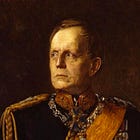Solutions to Decision Games
The Three Basic Options
The Connecting File has begun to publish decision exercises. As such exercises play an indispensable role in the study of tactics, this is, as Martha Stewart used to say, a good thing.
In honor of this initiative, I offer some thoughts on ways that the person running such exercises might respond to the solutions offered by participants.
The Historical Solution
The easiest way to wrap up a decision game makes use of a historical solution, a description of what a real person faced with a real problem in real life actually did, and the results that, well, resulted.
This “reveal,” as one of my colleagues at the old Case Method Project used to call it, can serve as a stand-alone conclusion to the exercise. Here’s what happened. Bus. It can also be used to jump start a critique of the decision made by the protagonist of the case.
“Corporal Contarini! Why do you think Lieutenant Colonel Pajari decided to do what he did on 10 December 1939? What was he thinking?”
“Major McGrath! How did Pajari see his mission?”
“Lieutenant Locon! Tell me about the Soviet forces on the east side of the lake. How did Pajari imagine them?”
Of course, you can only offer an historical solution if the problem itself was found in Clio’s closet. To put things another way, those who would practice the art of conducting decision games should start with the sort of exercises that George Catlett Marshall called “historical map problems.”
The Leader’s Solution
When presenting a solution to his subordinates, the leader of a unit will find it useful to describe the orders that he himself would give in the situation in question. This serves several ends.
By offering his own solution to the problem, the leader …
leads by example, making it clear that he is willing to do anything (and everything) that he asks his men to do
opens a window into his own thinking
shows his subordinates what a good order looks like
models the proper use of terms of art and, when drawing, symbols
As is the case with historical map problems, the leader can either end the exercise with his solution, or ask his subordinates to challenge his thinking.
“Lieutenant Colonel Caroe! Why did you chose to attack along the northern edge of the lake? The southern route, it seems, offered better cover from direct fire and concealment from aerial observation.
“Major Friedman! You began your attack with a five-minute bombardment of the enemy position. What led you to choose that duration? What would five minutes worth of 155 do that four could not?
The Moltke Method
The OG of the modern decision exercise, Helmuth Karl Bernhard Graf von Moltke (1800-1891), liked to conclude a decision game by talking through a solution offered by one of the participants. In this way, he avoided the pernicious practice, so often seen in the academic world, of placing too much value on his own ideas.
“Major Corrigan chose the following course of action. Let’s see how it might play out.”
In the course of doing this, Moltke might point out that measures proposed by some players would prove impractical. At the same time, he made it clear that, as some Buddhists like to say, “there are many paths up the same mountain.”
To Share, Subscribe, or Support:







A very thoughtful discussion of instructional techniques. I submit that Graf von Moltke was not just the OG of tactical instruction, but very likely the Grand Old Man. It would take a gifted instructor to guide and control discussions using his technique, but what amazing potential benefits!